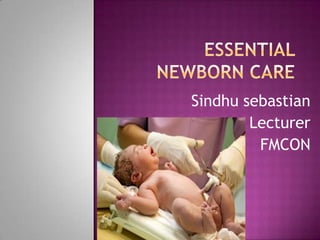
essentialnewborncarefor3rdyearbsc-130517013504-phpapp01 (3).pdf
- 2. Essential newborn care is a comprehensive strategy to reduce the death of newborn through cost effective interventions before conception, during pregnancy, immediately after birth and postnatal period
- 3. 1. To make sure baby is thriving 2. Early detection of problems or danger signs 3. Helping the mother to meet the baby’s basic needs –warmth, feeding, infection prevention 4. Baby breast feed within 1st hour 5. Advising and encouraging mother rot breast feed exclusively 6. Advising mother and family Members about danger signs and baby care 7. Treatment of key problems such as asphyxia and sepsis 8. Making plans for continuing care immunizations and growth monitoring
- 4. 1. Prepare for baby’s birth 2. Immediate newborn care 3. Newborn care during the first day 4. Newborn history and physical examination 5. Care of newborn during the first 28 days 6. Teach and counsel mother and family about the newborn care
- 5. a. Prevent infection WHO-32% newborn death due to infection Wash hands Personal contact infection Use the three infection prevention steps before the baby is born-equipment, supplies and linen and surface Decontamination Cleaning High level of disinfection and sterilization
- 6. Wear gloves Protect yourself from splashes or spills of blood amniotic fluids –wear eye protection, shoes ,face mask and apron b. Prepare the birth room Make sure that the room is Clean Warm Light Private
- 7. C. Keep records Newborn record cards Immunization cards Mothers records of AN, labor and delivery d. Collect the equipment supplies medicines for the birth room and immediate postnatal care
- 8. Immediate newborn care is based on the knowledge of midwife of his transitional requirement and capabilities.
- 9. Chance of heat loss by convection ,conduction radiation and evaporation- so optimal thermal environment in delivery room.eg switch of the fan – convection Closing curtains-radiation
- 11. A. INITIAL CARE As the baby ‘s head is born wipe or suction out the excess mucus from the nose /mouth Note the time of birth and sex of the baby
- 12. b. clearing the airway Hold the baby’s head lower than the body and turn to side for drainage Wipe off baby’s face and fluids from the nose and mouth Suction the nasal and oral passage with soft rubber bulb syringe or mucus sucker If necessary mechanical suction
- 13. c. Decide if baby needs resuscitation A baby who is not breathing ,breathing is less than 30 breaths per minutes or is gasping needs resuscitation Quickly clamp and tie and cut the cord leaving stump at least 10 cm long Put baby on flat warm surface and start resuscitation
- 14. d. Clamping and cutting the cord Tie the cord securely on two place Tie the first one 2 fingers away from the baby’s abdomen and second one from 4 fingers away from the baby’s abdomen Use a small gauze piece to cover the part of the cord to prevent splashing of blood while cutting the cord Cut the cord between the ties Do not put anything on the cord stump
- 15. e.dry and stimulate the baby Rub up and down the baby’s back using clean warm cloth f. Assess the baby’s breathing and colour Face and chest –pink not gray or blue –pink indicate good sign of adequate breathing and circulation Blue colour of tongue, lips and trunk –sign of lack of oxygen in blood Bluish colour only on hands and feet –present for 1-2 days after the birth normal
- 16. g. Preventing infection Aseptic technique h. Maintaining the body temperature Keep the baby's body warm Wipe of dry the baby Bodily contact with mother Radiant warmer -200 watt bulb Warmed blankets
- 17. Prevention of heat loss Remove the wet towel and cover with warm blankets Skin to skin contact with mother Keep the baby mothers chest as soon the baby is born Breast feeding with in the first hour
- 18. i. Preventing the injury Handle gently j. Assessing the baby’s condition APGAR k. Weight l. Clothing m. Eye care
- 19. n. Identification Name bands Remain until gets discharge Skin to skin contact with the mother Have the mother to start breast feeding
- 20. Close observation at least for 4-8 hours Any excess mucus from mouth Any bleeding from umbilical cord Hourly temperature until it stabilize and remain above 36 degree
- 21. o. Administer inj. vit k
- 22. a. Assess the baby b. Breathing c. Warmth d. Colour e. Bleeding f. Give normal newborn care Keep warm Support breast feeding Eye cre cord care ,skin care ,
- 23. g. other care for any problems or needs Newborn physical examination Common newborn problems h. Immunizations BCG and polio
- 24. a. Take history b. Objectives of physical examination To detect congenital anomalies To detect illness and birth injuries To record body measurement and vital signs c. Identify needs or problems
- 25. Observation General care Warmth Sleep Vital signs check Loving care Weight
- 26. Protection from infection Skin care The head The mouth Eye care Care of umbilical cord
- 27. Genital care Bath Early and exclusive breast feeding Elimination Stool
- 28. Immunization Safety and security Newborn danger signs Plan for follow up visits